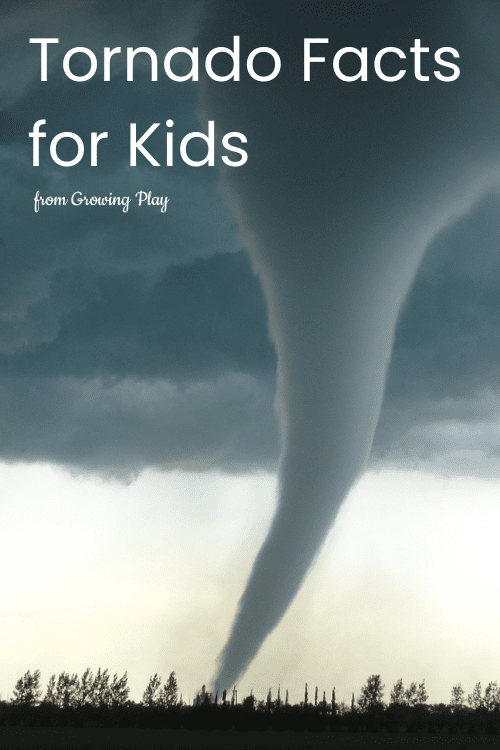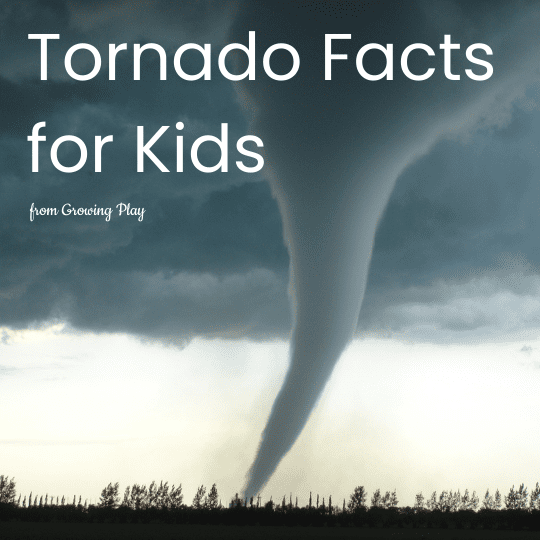Tornado Facts for Kids

Whoosh! Did you feel that? It felt like wind or was it a tornado? Tornadoes bring extremely high winds that are powerful enough to rip down power lines, tear down homes, and uproot trees. Have you ever seen a tornado? How about the effects of one? Tornadoes can be scary, so it’s important you stay safe when one comes through your area. Believe it or not, one of the safest places you can be is in a basement. Learn why with these tornado facts for kids. Plus, learn more tips and tricks for staying safe.
The Formation of a Tornado
1. Tornadoes can happen at any time of year, but are most common in spring and summer. They are also more common in the northern hemisphere than the southern hemisphere.
2. Tornadoes form in dry air, typically from a thunderstorm. When warm air collides with cold air, it creates an updraft. This updraft spins, and if it’s strong enough, a tornado forms.
Tornado Facts for Kids – What does a Tornado Look Like?
3. A typical tornado first appears as a funnel cloud in the sky. From there, it can lengthen and expand creating a deadly force.
4. Tornadoes can vary greatly in size – some are only a few feet wide, while others can be over 2 miles wide! Could you imagine seeing a tornado two miles wide?
How Long do Tornados Last?
5. Tornadoes can last for just a few minutes, or up to several hours. The longest lasting tornado was three and a half hours from Missouri to Indiana.
6. In terms of speed, tornadoes typically travel at around 30 miles per hour, but can reach speeds of over 70 miles per hour. That’s faster than a car!
Tornado Facts for Kids – Wind Speed of a Tornado
7. Tornado wind speeds can vary greatly. The strength of tornadoes is based on the enhanced Fujita scale, or f scale for wind speed. f0 tornadoes have wind speeds between 40 and 72 miles per hour. f1 tornadoes denote wind speeds of between 73 and 112 miles per hour, f2 tornadoes have high wind speeds between 113 and 157 miles per hour, and f3 tornadoes have wind speeds of between 158 to 206 miles per hours. Strong winds of up to 260 miles per hour are present during a f4 tornado and f5 tornadoes have wind speeds between 261 and 318 miles per hour. The winds of a tornado can even be as strong as 379 miles per hour with a f6 tornado. Can you imagine that?
Damage Caused by Tornadoes
8. Tornadoes create a lot of damage and are one of the most violent weather events on Earth. They’ve been known to level cars, mobile homes, and even entire towns!
9. The deadliest tornado in United States history was the Tri-State tornado. It ranked a f5 on the f scale and caused much damage across Missouri, Illinois, and Indiana, including 695 fatalities.
Tornado Facts for Kids – Where do Tornadoes Occur?
10. Tornadoes can occur anywhere in the world, but are most common in tornado alley. Tornado alley is a nickname for an area in the Midwestern United States where tornadoes are especially common. These states include North Dakota, South Dakota, Texas, Oklahoma, Kansas, Nebraska, Missouri, Iowa, and Illinois. Do you live in tornado alley?
11. There are several reasons why tornado alley is such a tornado-prone region. One is that it lies in the path of warm air from the Gulf of Mexico colliding with cold air from the Rocky Mountains. This creates the perfect conditions for a tornado outbreak.
12. An average of 1200 tornadoes touch down in the United States each year, and around half of those occur in tornado alley. Did you know there were that many tornadoes in the United States?
What Can you do When There is a Tornado in your Area?
13. Thankfully, there are ways to predict when a tornado might form, and warnings can be issued so people can take shelter. The National Weather Service will issue a tornado watch or a tornado warning depending on whether or not a tornado has been seen in the sky.
14. If you’re ever in an area where a tornado is predicted, the best thing to do is to go indoors, and stay away from windows. A basement is your best option to seek shelter in. If you’re caught outdoors, try to find a low-lying area such as a ditch or culvert to take shelter in.
Tornadoes can be very dangerous, but now you know what you can do to stay safe! Find shelter in a basement or other low-lying area. Protect yourself and others from the high wind speeds and stay away from windows. Unless you’re a storm chaser, you should not try to challenge the storm and even then, I would just stay in the basement.
WANT MORE FUN FACTS FOR KIDS?
Check out these fun facts for kids here and browse all the other topics at the bottom of the post.
Read about hurricanes here.
You can download a FREE blizzard packet here and learn fun facts.



